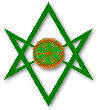The UFO Detector drawing UFODETCR.GIF does not include any dimensions as it is only intended as a general guideline for creating your own detector. These notes are intended to help that process along. The Detector probably has two design parameters that must be taken into consideration as one proceeds with the construction process. The first consideration is that most of the parts will depend on the size of the bar magnet. A magnet 5" to 6" long and 3/8" in diameter is a good size to work with. The other consideration is the overall size of the wooden base. In order that the Detector not be triggered by air currents in its vicinity, the wooden base should be designed to fit under a clear plastic (or glass) cover of some sort. Some other details to consider may not be apparent from the drawing. The brass support band (4) should be dimpled in the center with something like a finishing nail while being careful not to puncture the metal. The idea is to give the brass nail (3) something to ride in so the band does not slip off of the nail easily. Also, the ends of the brass band need to have holes drilled through them which are larger than the diameter of the magnet. The reason for this is that the magnet is not passing through the band at 90 degrees but rather at a more acute angle, thereby requiring a larger hole. The 12 ga. copper wire (6) must be electrically connected to the brass band by soldering, but it can be fastened to the magnet with tape (or whatever), just so the wire stays aligned with the axis of the magnet. In this way the brass stand, the brass nail the brass strap, and the 12 ga. wire are all electrically connected when the magnet and its brass band are resting on the nail attached to the stand. The copper loop (7) is made out of a continuous piece of 10 ga. solid copper wire so that, when the magnet assembly is balanced on the stand, the 12 ga. wire extending from the end of the magnet is centered in the middle of the loop. In this way there is no electrical connection between the copper loop and the magnet assembly until the magnetic field is disturbed enough to cause the magnet to swing around a few degrees and make contact with the loop. Both the base of the copper loop and the brass stand are fastened to the wooden base with a brass wood screw (8). Copper wires (not shown) can be attached to each screw allowing an external electrical circuit to sense any connection between the two circuits. The optional iron nail (9) is used, as illustrated in the drawing, to skew the local magnetic field so that the whole detector will have to be realigned in order for the magnet to be centered in the copper loop. In this way any increase or decrease in the ambient magnetic field will cause the magnet to go off of center axis and contact the side of the copper loop causing a connection between the two circuits.
Return to the SLU Home World |
